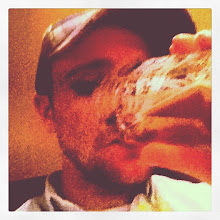This post is from my Berliner Weiss brew day I had two weekends ago. My goal was both to get a great summer beer in the fermentor, and to re-try the complicated double decoction technique that I've had trouble with in the past.
The Beer:
My Berline Weisse is a light and refreshing wheat beer at about 3% ABV, but with a funky, sour flavor from wild yeast. It's an old German style that's expensive and hard to find on shelves, but brewing it at home allows me to treat it like the great summer thirst quencher that it is.
The Method:
This recipe is a re-brew of a berliner weisse I brewed last year, but instead of using a yeast blend, I'm pitching the sour, lactobacillus strain first, and the ale yeast strain a day or two later. This should give the lacto a head start and result in a quicker souring. I'm also giving another try at a double decoction. It's a difficult German mash schedule that gives so many of their beers a traditional, complex malt flavor. It should also help funkify it by allowing me to use no boil, and get only a few IBU's from mash hopping.
Recipe:
3# Pilsner (55%)
2.5# Wheat (45%)
1 oz. of Hallertau hops during decoction for just a few IBU's.
1.033 O.G
The Decoction Mash:
Protein rest. Mash in at 132 using a thick ratio of 1 qt/lb. 5.5 qts of water at 142 degrees into 5.5 lbs of malt. Includes 1 ounce of Hallertau.
 |
| Protein rest mashes look a bit more milky. Also, the hops are included here since there is no boil. |
This rest lasts for 1 hour. So, at 30 minutes, decoct the thickest 40% of the mash using (roughly) the following schedule:
Over 5 minutes, bring the decoction to 150 degrees. Rest for 5 minutes, then bring to a boil over another 5 minutes. Boil this decoction for 15 minutes. Total decoction time: 30 minutes.
 |
| This is the beginning of the decoction. Very little liquid was removed from the mash, so I'm basically about to boil grains here. |
 |
| At the end of the decoction, the grains are darker from caramelization. |
Return to mash, stir, and check temperature. I only reached 130. This decoction wasn't successful in raising the temperature of the mash, but the chemistry of the mash should be different. I infused two quarts of boiling water to bring the mash up to 148. Next step is to mash for one hour, decocting again at 30 minutes.
 |
| Picture of the mash after sacchrification rest and before second decoction. Liquid is separating at the top, with some hops floating as well. |
Use the same schedule as the first decoction, only rest at 170 degrees. Boil for 15 minutes, bringing the total decoction time to 30 minutes. Add back to the mash to bring it to 170 degrees. The second decoction also didn't raise the temperature, so I added boiling water to bring it to 165.
 |
| After the first decoction wasn't successful at raising the temperature, I took a larger amount in the second decoction, along with more liquid. |
 |
| Decoction #2 in the kettle. |
Rest at mashout temp for 15 minutes. Lauter into kettle, then sparge with 170 degree water to get to 5.5 gallons. Let it cool naturally in the kettle, covered until it reaches 80 degrees. Oxygenate, then pitch Lacto yeast. After two days, pitch English Ale yeast from previous batch.
Decoction Recap:
So while neither of my decoctions were successful in hitting my temperature rests, I should still have all the chemistry benefits from procedure. After re-reading the decoction section of
New Brewing Lager Beer, and watching some
YouTube clips, I picked up some new methods that I'll write about in my next decoction attempt. That blog should be in a few weeks, when I try a double decocted hefeweizen.
Decoct on.







